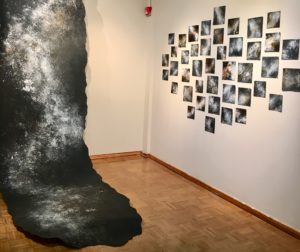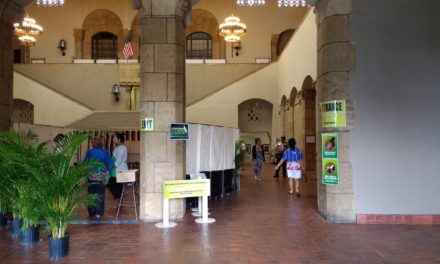By Katlin Cilliers | Staff Writer
The rainy evening did not keep art lovers from gathering at Koa Gallery this Saturday, March 3, to honor artists Rio Suzuki and Yumiko Glover’s in their exhibit, titled “Mujō: Aesthetics of Impermanence.” Drawing inspiration from concepts such as life’s transience and preciousness, both artists received enthusiastic compliments on their pieces.
The exhibit has been in the gallery’s pipeline since 2015, and finally came to life this month. The artists, who met during their undergraduate years at University of Hawai‘i at Mānoa, joined talents for the show soon after Glover finished her graduate studies.
Their styles differ when it comes to their choice of mediums, from pieces of wood to baking soda on acrylic. The contrasting artworks seemed to complement each other. Observers ambled through the gallery, being fed food for thought on the way.
08.06 – Evanescence (By Yumiko Glover)
The recycled and hand-painted wood parts in Glover’s piece allude to the bombings of Hiroshima and Nagasaki in 1945. In it, fragmented shades of red portrait the shattered lives of people affected by the event. However, Glover said that her art is not intended to evoque sadness.
“My purpose for creating this is not re-create the war zone, to tell people how terrible it was,” she said. “That’s not my focus. I am more emphasized in on the preciousness of life that lasted until that moment, so that’s like, this vintage kimono from pre-war [points to kimono pieces in sculpture] to remind of the presence of women, children, small animals and nature often forgotten when we talk of nuclear bomb.”

“Absolutely exquisite,” said Hope Crenshaw, an art enthusiast, about Rio’s artwork.
Frozen (by Rio Suzuki)
Suzuki steers away from the traditional acrylic on canvas, using innovative media and materials on her pieces. She points to spots made with baking soda and Roiboos tea throughout the piece, protected by a layer of Plexiglas. When describing its rich details, she mentions that certain patterns were created using a sponge and acrylic paint.
“It’s very improvisational, so I just try not to think much when I am in the studio,” she said. “[Instead, I’m] just moving with the changes.”
The improvisational aspect seems to permeate throughout her work. She says she doesn’t really have a clear picture of what her art pieces are going to look like until she is done.
“I don’t know, but I just figure out how it’s going to be work each [time],” she said. “You know, those are tea. I can’t drink really caffeine, you know. Those marks are from Roiboos tea. So that’s why I just incorporate my every day material, you know? Baking soda, tea.”
Suzuki’s main influence derives from her previous experiences with buddhism, and later on, zen buddhism.
“I have life experiences in Japan and here … things are not really suitable for the time, but then you gonna accept the things,” she said. “You have to be prepare for your life and this, you know. That’s zen [buddhism]. So moving with the changes, just accept. Because things are changing. And you have to be change, right.”
Some of the gallery visitors were raving about the beauty of Suzuki’s art. Hope Crenshaw, who divides her time between Cham, in Switzerland, and Honolulu, was particularly enamored with one of Suzuki’s long, horizontal paintings that draped all the way down to the floor. It strikingly resembled the Milky Way.
“That is exquisite, absolutely exquisite,” Crenshaw said. “It looks like she painted it right out of the night sky. It looks like she got a cut out of the sky and found a way to drape it, so we can be near it. I would buy that piece, instantly.”







